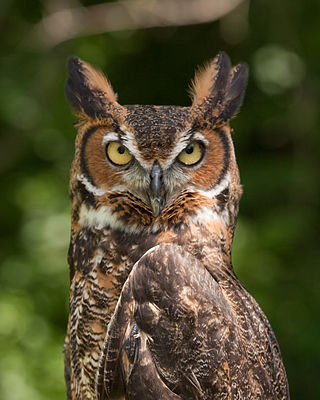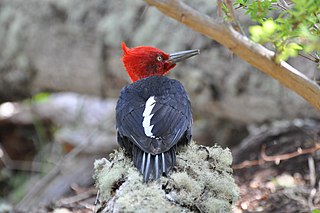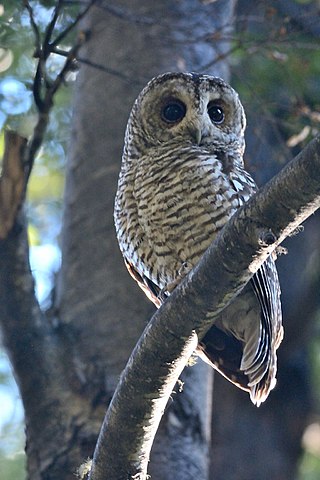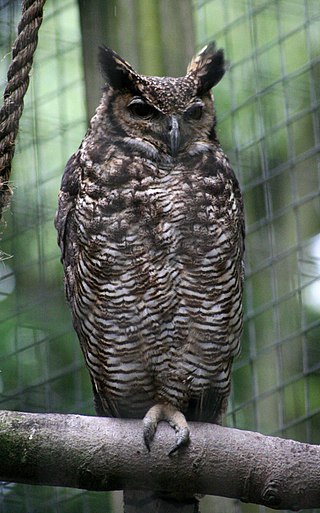
The American horned owls and the Old World eagle-owls make up the genus Bubo, at least as traditionally described. The genus name Bubo is Latin for owl.

The Eurasian eagle-owl is a species of eagle-owl that resides in much of Eurasia. It is also called the Uhu and it is occasionally abbreviated to just the eagle-owl in Europe. It is one of the largest species of owl, and females can grow to a total length of 75 cm (30 in), with a wingspan of 188 cm, with males being slightly smaller. This bird has distinctive ear tufts, with upper parts that are mottled with darker blackish colouring and tawny. The wings and tail are barred. The underparts are a variably hued buff, streaked with darker colouring. The facial disc is not very defined and the orange eyes are distinctive.

The great horned owl, also known as the tiger owl, or the hoot owl, is a large owl native to the Americas. It is an extremely adaptable bird with a vast range and is the most widely distributed true owl in the Americas. Its primary diet is rabbits and hares, rats and mice, and voles, although it freely hunts any animal it can overtake, including rodents and other small mammals, larger mid-sized mammals, birds, reptiles, amphibians, and invertebrates.

Blakiston's fish owl, the largest living species of owl, is a fish owl, a sub-group of eagle-owls which specialize in hunting in riparian areas. It is native to China, Japan, and the Russian Far East. This species is a part of the family known as typical owls (Strigidae), which contains most species of owl. Blakiston's fish owl and three other piscivorous owls are placed with some eagle-owls in the genus Ketupa. Its habitat is riparian forest with large, old trees for nest sites that is near lakes, rivers, springs, and shoals that do not freeze in winter. Henry Seebohm named this bird after the English naturalist Thomas Blakiston, who collected the original specimen in Hakodate on Hokkaidō, Japan in 1883.

The spot-bellied eagle-owl, also known as the forest eagle-owl is a large bird of prey with a formidable appearance. It is a forest-inhabiting species found in the Indian Subcontinent and Southeast Asia. This species is considered part of a superspecies with the barred eagle-owl, which looks quite similar but is allopatric in distribution.

The rock shag, also known as the Magellanic cormorant, is a marine cormorant found around the southernmost coasts of South America. Its breeding range is from around Valdivia, Chile, south to Cape Horn and Tierra del Fuego, and north to Punta Tombo in Argentina. In winter it is seen further north, with individuals reaching as far as Santiago, Chile on the west coast and Uruguay on the east. The birds also breed around the coasts of the Falkland Islands.

The Magellanic woodpecker is a species of large woodpecker found in southern Chile and southwestern Argentina; it is resident within its range. This species is the southernmost example of the genus Campephilus, which includes the famous ivory-billed woodpecker.

The Madagascar owl, also known as the Madagascan owl or Madagascar long-eared owl, is a medium-sized owl endemic to the island of Madagascar. It is sometimes considered to be conspecific with the long-eared owl.

The spotted wood owl is an owl of the earless owl genus, Strix. Its range is disjunct; it occurs in many regions surrounding Borneo, but not on that island itself.

The rufous-legged owl is a medium-sized owl. It is found in Argentina and Chile.

The Magellanic tapaculo is a small passerine bird in the tapaculo family Rhinocryptidae that is found in southern South America.
Abrothrix olivacea, also known as the olive grass mouse or olive akodont, is a species of rodent in the genus Abrothrix of family Cricetidae. It is found from northern Chile into southern Chile and Argentina, including the islands of Tierra del Fuego. It is prone to large swings in population size.
Morgan's gerbil mouse, also known as the western Patagonian laucha, is a South American species of rodent in the family Cricetidae. It is named for J. P. Morgan, one of the sponsors of the expedition that first identified the species.
Irenomys tarsalis, also known as the Chilean climbing mouse, Chilean tree mouse, or long-footed irenomys, is a rodent found in Chile, from about 36° to 46°S, and in adjacent Argentina, mainly in forests. It is a large, long-tailed, soft-furred mouse characterized by grooved upper incisors and specialized molars with transverse ridges, divided by deep valleys, which are connected by a transverse ridge along the midline of the molars.
Oligoryzomys magellanicus, also known as the Patagonian colilargo and the Magellanic pygmy rice rat, is a species of rodent in the genus Oligoryzomys of the family Cricetidae. It is found in the southernmost parts of Argentina and Chile, including Tierra del Fuego and other outlying islands. Its karyotype has 2n = 54 and FNa = 66.

The Pharaoh eagle-owl is a species of owl in the family Strigidae. It is native to Algeria, Chad, Egypt, Eritrea, Iran, Iraq, Israel, Jordan, Kuwait, Libya, Mali, Mauritania, Morocco, Niger, Oman, Palestine, Qatar, Saudi Arabia, Senegal, Sudan, Tunisia and the United Arab Emirates.

Fraser's eagle-owl is a species of African owl in the family Strigidae. It is named after the British zoologist Louis Fraser.

The barred eagle-owl, also called the Malay eagle-owl, is a species of eagle owl in the family Strigidae. It is a member of the large genus Ketupa which is distributed on most of the world's continents. This relatively little-known species is found from the southern Malay Peninsula down a string of several of the larger southeast Asian islands to as far as Borneo. It forms a superspecies with the physically similar but larger spot-bellied eagle-owl, although the two species appear to be allopatric in distribution.
The Usambara eagle-owl, also called the East African nduk eagle-owl or Vosseier's eagle-owl, is a taxon of owl in the family Strigidae. It is now regarded as a subspecies of Fraser's eagle-owl. It is endemic to the Usambara Mountains in Tanga Region of Tanzania.

The South American great horned owl, also known as the Colombian great horned owl, Venezuelen great horned owl, or desert great horned owl, is a subspecies of the great horned owl, Bubo virginianus. It lives in tropical South America. It generally occurs in more open areas than the North American great horned owls, and avoids dense humid forest, e.g. the Amazon Rainforest. Unlike other subspecies of the great horned owl, the eyes of the South American horned owl are amber rather than yellow. Although the largest owl in its range, it is a relatively small horned owl.
















